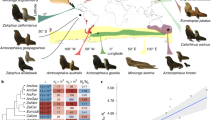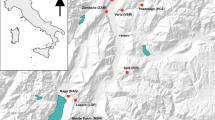Abstract
There is an increasing awareness that the long-term viability of endemic island populations is negatively affected by genetic factors associated with population bottlenecks and/or persistence at small population size. Here we use contemporary samples and historic museum specimens (collected 1888–1938) to estimate the effective population size (N e) for the endangered yellow-eyed penguin (Megadyptes antipodes) in South Island, New Zealand, and evaluate the genetic concern for this iconic species. The South Island population of M. antipodes—constituting almost half of the species’ census size—is thought to be descended from a small number of founders that reached New Zealand just a few hundred years ago. Despite intensive conservation measures, this population has shown dramatic fluctuations in size over recent decades. We compare estimates of the harmonic mean N e for this population, obtained using one moment and three likelihood based-temporal methods, including one method that simultaneously estimates migration rate. Evaluation of the N e estimates reveals a harmonic mean N e in the low hundreds. Additionally, the inferred low immigration rates (m = 0.003) agree well with contemporary migration rate estimates between the South Island and subantarctic populations of M. antipodes. The low N e of South Island M. antipodes is likely affected by strong fluctuations in population size, and high variance in reproductive success. These results show that genetic concerns for this population are valid and that the long-term viability of this species may be compromised by reduced adaptive potential.

Similar content being viewed by others
References
Akst EP, Boersma PD, Fleischer RC (2002) A comparison of genetic diversity between the Galapagos Penguin and the Magellanic Penguin. Conserv Genet 3:375–383
Allendorf FW (1986) Genetic drift and the loss of alleles versus heterozygosity. Zoo Biol 5:181–190
Beaumont MA (2003) Estimation of population growth or decline in genetically monitored populations. Genetics 164:1139–1160
Begon M, Townsend CR, Harper LL (2006) Ecology: from individuals to ecosystems. Blackwell Publishing, Malden
Belkhir K, Borsa P, Chikhi L, Raufaste N, Bonhomme F (1996–2004) GENETIX 4.05, logiciel sous Windows TM pour la génétique des populations. Laboratoire Génome, Populations, Interactions, Université de Montpellier II, Montpellier
Berthier P, Beaumont MA, Cornuet JM, Luikart G (2002) Likelihood-based estimation of the effective population size using temporal changes in allele frequencies: a genealogical approach. Genetics 160:741–751
Boessenkool S, King TM, Seddon PJ, Waters JM (2008) Isolation and characterization of microsatellite loci from the yellow-eyed penguin (Megadyptes antipodes). Mol Ecol Resour 8:1043–1045
Boessenkool S, Austin JJ, Worthy TH, Scofield P, Cooper A, Seddon PJ, Waters JM (2009a) Relict or colonizer? Extinction and range expansion of penguins in southern New Zealand. Proc R Soc Lond B Biol Sci 276:815–821
Boessenkool S, Star B, Waters JM, Seddon PJ (2009b) Multilocus assignment analyses reveal multiple units and rare migration events in the recently expanded yellow-eyed penguin (Megadyptes antipodes). Mol Ecol 18:2390–2400
Bull E (2005) Components influencing lifetime reproductive success in yellow-eyed penguins. Bachelor of Science (Honours) thesis. Department of Zoology, University of Otago, Dunedin
Clout M (2001) Where protection is not enough: active conservation in New Zealand. Trends Ecol Evol 16:415–416
Darby JT, Seddon PJ (1990) Breeding biology of the yellow-eyed penguin (Megadyptes antipodes). In: Davis LS, Darby JT (eds) Penguin biology. Academic Press Inc, San Diego, pp 45–62
Duncan RP, Blackburn TM (2004) Extinction and endemism in the New Zealand avifauna. Global Ecol Biogeogr 13:509–517
Efford MG, Edge KA (1998) Can artificial brood reduction assist the conservation of yellow-eyed penguins (Megadyptes antipodes)? Anim Conserv 1:263–271
Frankham R (1995) Effective population size/adult population size ratios in wildlife—a review. Genet Res 66:95–107
Frankham R, Ballou JD, Briscoe DA (2002) Introduction to conservation genetics. Cambridge University Press, Cambridge
Franklin IR (1980) Evolutionary change in small populations. In: Soule ME, Wilcox BA (eds) Conservation biology: an evolutionary—ecological perspective. Sinauer Associates, Sunderland
Franklin IR, Frankham R (1998) How large must populations be to retain evolutionary potential? Anim Conserv 1:69–70
Fraser DJ, Hansen MM, Ostergaard S, Tessier N, Legault M, Bernatchez L (2007a) Comparative estimation of effective population sizes and temporal gene flow in two contrasting population systems. Mol Ecol 16:3866–3889
Fraser DJ, Jones MW, McParland TL, Hutchings JA (2007b) Loss of historical immigration and the unsuccessful rehabilitation of extirpated salmon populations. Conserv Genet 8:527–546
Gill JM, Darby JT (1993) Deaths in yellow-eyed penguins (Megadyptes antipodes) on the Otago Peninsula during the summer of 1990. New Zeal Vet J 41:39–42
Goudet J (2002) FSTAT, a program to estimate and test gene diversities and fixation indices (version 2.9.3). Insitute of Ecology, Lausanne
Hansen MM, Ruzzante DE, Nielsen EE, Bekkevold D, Mensberg KLD (2002) Long-term effective population sizes, temporal stability of genetic composition and potential for local adaptation in anadromous brown trout (Salmo trutta) populations. Mol Ecol 11:2523–2535
Jamieson IG (2007) Has the debate over genetics and extinction of island endemics truly been resolved? Anim Conserv 10:139–144
Jamieson IG, Grueber CE, Waters JM, Gleeson DM (2008) Managing genetic diversity in threatened populations: a New Zealand perspective. New Zeal J Ecol 32:130–137
Jorde PE, Ryman N (2007) Unbiased estimator for genetic drift and effective population size. Genetics 177:927–935
Keller LF, Waller DM (2002) Inbreeding effects in wild populations. Trends Ecol Evol 17:230–241
Lande R, Shannon S (1996) The role of genetic variation in adaptation and population persistence in a changing environment. Evolution 50:434–437
Leberg P (2005) Genetic approaches for estimating the effective size of populations. J Wildl Manage 69:1385–1399
Lynch M, Lande R (1998) The critical effective size for a genetically secure population. Anim Conserv 1:70–72
McKinlay B (2001) Hoiho (Megadyptes antipodes) recovery plan 2000–2025. Department of Conservation, Wellington
Moore PJ (2001) Historical records of yellow-eyed penguin (Megadyptes antipodes) in southern New Zealand. Notornis 48:145–156
Nei M, Tajima F (1981) Genetic drift and estimation of effective population size. Genetics 98:625–640
NIWA (2008) Climate change: projections for New Zealand. National institute of water & atmospheric research, Wellington, New Zealand. Available from www.niwascience.co.nz/ncc/clivar/scenarios. Downloaded on: 15 March 2009
Nunney L (1999) The effective size of a hierarchically structured population. Evolution 53:1–10
Palstra FP, Ruzzante DE (2008) Genetic estimates of contemporary effective population size: what can they tell us about the importance of genetic stochasticity for wild population persistence? Mol Ecol 17:3428–3447
Peacock L, Paulin M, Darby JT (2000) Investigations into climate change influence on population dynamics of yellow-eyed penguins Megadyptes antipodes. New Zeal J Zool 27:317–325
Peel D, Ovenden JR, Peel SL (2004) NeEstimator: software for estimating effective population size, version 1.3. Queensland Government, Department of Primary Industries and Fisheries, Australia
Pollak E (1983) A new method for estimating the effective population size from allele frequency changes. Genetics 104:531–548
Rice WR (1989) Analyzing tables of statistical tests. Evolution 43:223–225
Richdale LE (1957) A population study of penguins. Clarendon Press, Oxford
Rousset F (2008) GENEPOP ‘007: a complete re-implementation of the GENEPOP software for Windows and Linux. Mol Ecol Resour 8:103–106
Sefc KM, Payne RB, Sorenson MD (2003) Microsatellite amplification from museum feather samples: effects of fragment size and template concentration on genotyping errors. Auk 120:982–989
Taberlet P, Griffin S, Goossens B, Questiau S, Manceau V, Escaravage N, Waits LP, Bouvet J (1996) Reliable genotyping of samples with very low DNA quantities using PCR. Nucleic Acids Res 24:3189–3194
Tallmon DA, Luikart G, Beaumont MA (2004) Comparative evaluation of a new effective population size estimator based on approximate Bayesian computation. Genetics 167:977–988
van Heezik Y, Davis L (1990) Effects of food variability on growth rates, fledging sizes and reproductive success in the yellow-eyed penguin Megadyptes antipodes. Ibis 132:354–365
Walsh PS, Metzger DA, Higuchi R (1991) Chelex-100 as a medium for simple extraction of DNA for PCR-based typing from forensic material. Biotechniques 10:506–513
Wandeler P, Hoeck PE, Keller LF (2007) Back to the future: museum specimens in population genetics. Trends Ecol Evol 22:634–642
Wang JL (2001) A pseudo-likelihood method for estimating effective population size from temporally spaced samples. Genet Res 78:243–257
Wang JL, Whitlock MC (2003) Estimating effective population size and migration rates from genetic samples over space and time. Genetics 163:429–446
Waples RS (1989) A generalized approach for estimating effective population size from temporal changes in allele frequency. Genetics 121:379–391
Waples RS, Yokota M (2007) Temporal estimates of effective population size in species with overlapping generations. Genetics 175:219–233
Whitlock MC, Barton NH (1997) The effective size of a subdivided population. Genetics 146:427–441
Willi Y, Van Buskirk J, Hoffmann AA (2006) Limits to the adaptive potential of small populations. Annu Rev Ecol Evol Syst 37:433–458
Wright S (1931) Evolution in Mendelian populations. Genetics 16:97–159
Acknowledgments
We are very grateful to the Auckland Museum, American Museum of Natural History, Australian Museum, Canterbury Museum, Museum of Comparative Zoology, Natural History Museum Geneva, Natural History Museum Tring, Natural History Museum Paris, Museum of New Zealand Te Papa Tongarewa, Natural History Museum Vienna, Swedish Museum of Natural History, Otago Museum, South Australian Museum, Smithsonian Institution, Museum für Naturkunde Berlin and Craig Millar for supplying tissue samples of historic specimens. We thank the New Zealand Department of Conservation for help with collecting contemporary samples. We are indebted to Tania King for guidance and advice in the laboratory and we thank Stein Are Sæther for helpful discussions about analyses. We would further like to thank the ESF Science Networking Programme ConGen for organising the Conservation Genetics conference in Trondheim in May 2009 and for this special issue of Conservation Genetics. This research was supported by the Department of Zoology, University of Otago, including PBRF Research Enhancement Grants to PJS and JMW. Samples were collected under Department of Conservation permits SO-17933-FAU and OT-19097-RES and University of Otago Animal Ethics Approval 69/06.
Author information
Authors and Affiliations
Corresponding author
Electronic supplementary material
Below is the link to the electronic supplementary material.
Rights and permissions
About this article
Cite this article
Boessenkool, S., Star, B., Seddon, P.J. et al. Temporal genetic samples indicate small effective population size of the endangered yellow-eyed penguin. Conserv Genet 11, 539–546 (2010). https://doi.org/10.1007/s10592-009-9988-8
Received:
Accepted:
Published:
Issue Date:
DOI: https://doi.org/10.1007/s10592-009-9988-8




